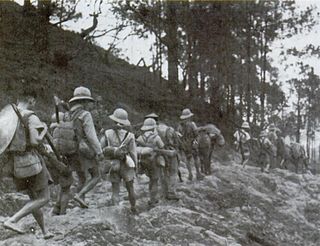 W
WIn the northern-hemisphere summer of 1940 Germany rapidly defeated the French Third Republic, and colonial administration of French Indochina passed to the French State. In September 1940 Japanese troops first entered parts of Indochina; and in July 1941 Japan extended its control over the whole of French Indochina. The United States, concerned by Japanese expansion, started putting embargoes on exports of steel and oil to Japan from July 1940. The desire to escape these embargoes and to become self-sufficient in resources ultimately contributed to Japan's decision to attack on December 7, 1941 the British Empire and simultaneously the USA and at Pearl Harbor, Hawaii). This led to the USA declaring war against Japan on December 8, 1941. The US then joined the side of the British Empire, already at war with Germany since 1939, and its existing allies in the fight against the Axis powers.
 W
W1940—1946 in French Indochina focuses on events that happened in French Indochina during and after World War II and which influenced the eventual decision for military intervention by the United States in the Vietnam War. French Indochina in the 1940s was divided into five protectorates: Cambodia, Laos, Tonkin, Annam, and Cochinchina. The latter three made up Vietnam. In 1940, the French controlled 23 million Vietnamese with 12,000 French soldiers, about 40,000 Vietnamese soldiers, and the Sûreté, a powerful police force. At that time, the U.S. had little interest in Vietnam or French Indochina as a whole. Fewer than 100 Americans, mostly missionaries, lived in Vietnam and U.S. government representation consisted of one consul resident in Saigon.
 W
W1947–1950 in French Indochina focuses on events influencing the eventual decision for military intervention by the United States in the First Indochina War. In 1947, France still ruled Indochina as a colonial power, conceding little real political power to Vietnamese nationalists. French Indochina was divided into five protectorates: Cambodia, Laos, Tonkin, Annam, and Cochinchina. The latter three made up Vietnam.
 W
WCOSARA was a Vietnamese aviation and transport company founded by Maurice Loubière. The company's office was located at 5–13, Turc Street, Saigon - now Hô Huân Nghiêp, Ho Chi Minh City.
 W
WThe First Indochina War began in French Indochina on December 19, 1946, and lasted until July 20, 1954. Fighting between French forces and their Việt Minh opponents in the south dated from September 1945. The conflict pitted a range of forces, including the French Union's French Far East Expeditionary Corps, led by the government of France and supported by the former emperor Bảo Đại's Vietnamese National Army against the People's Army of Vietnam and Việt Minh, led by Võ Nguyên Giáp and Hồ Chí Minh. Most of the fighting took place in Tonkin in northern Vietnam, although the conflict engulfed the entire country and also extended into the neighboring French Indochina protectorates of Laos and Cambodia.
 W
WThe Japanese coup d'état in French Indochina, known as Meigō Sakusen , was a Japanese operation that took place on 9 March 1945, towards the end of World War II. With Japanese forces losing the war and the threat of an Allied invasion of Indochina imminent, the Japanese were concerned about an uprising against them by French colonial forces.
 W
WThe Kingdom of Kampuchea was a Japanese puppet state from 9 March 1945 to 16 October 1945.
 W
WTrotskyism in Vietnam was represented by those who, in left opposition to the Indochinese Communist Party (PCI) of Nguyen Ai Quoc, identified with the call by Leon Trotsky to re-found "vanguard parties of proletariat" on principles of "proletarian internationalism" and of "permanent revolution". Active in the 1930s in organising the Saigon waterfront, industry and transport, Trotskyists presented a significant challenge to the Moscow-aligned party in Cochinchina. Following the September 1945 Saigon uprising against the restoration of French colonial rule, Vietnamese Trotskyists were systematically hunted down and eliminated by both the French Sûreté and the Communist-front Viet Minh.
 W
WThe Việt Minh was a national independence coalition formed at Pác Bó by Hồ Chí Minh on May 19, 1941. Also known as the Việt Minh Front, it was created by the Indochinese Communist Party as a form of united national front in Vietnam.
 W
WThe War in Vietnam, codenamed Operation Masterdom by the British, and also known as the Southern Resistance War by the Vietnamese, was a post–World War II armed conflict involving a largely British-Indian and French task force and Japanese troops from the Southern Expeditionary Army Group, versus the Vietnamese communist movement, the Viet Minh, for control of the southern half of the country, after the unconditional Japanese surrender.
 W
WIn the northern-hemisphere summer of 1940 Germany rapidly defeated the French Third Republic, and colonial administration of French Indochina passed to the French State. In September 1940 Japanese troops first entered parts of Indochina; and in July 1941 Japan extended its control over the whole of French Indochina. The United States, concerned by Japanese expansion, started putting embargoes on exports of steel and oil to Japan from July 1940. The desire to escape these embargoes and to become self-sufficient in resources ultimately contributed to Japan's decision to attack on December 7, 1941 the British Empire and simultaneously the USA and at Pearl Harbor, Hawaii). This led to the USA declaring war against Japan on December 8, 1941. The US then joined the side of the British Empire, already at war with Germany since 1939, and its existing allies in the fight against the Axis powers.